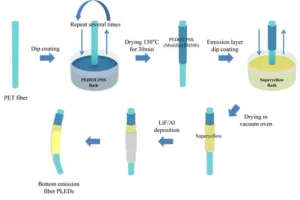A research team headed by Professor Kyung-Cheol Choi in the Department of Electrical Engineering at the Korea Advanced Institute of Science and Technology (Daejeon, South Korea) is developing Polymer Light Emitting Diodes that have the form factor of a fiber. One possible application of these fiber-like PLEDs is in wearable displays.

The most recent results of the team are reported in an article entitled “High Luminance Fiber-Based Polymer Light-Emitting Devices by a Dip-Coating Method.” It was published in the July 14th issue of Advanced Electronic Materials. A copy of the article is available for purchase on-line and can be found here.
The starting point for the team’s research was the general observation that displays are typically produced on a physically rigid substrate. If the display is to be used in a wearable application, then a common step is to attach the rigid substrate onto the surface of clothes. This approach has been only modestly successful because an inflexible display both ignores and contradicts the elastic and/or deformable characteristics of the underlying fabric.
The approach adopted by the team to address this issue is based on the development of fiber-like PLEDs. The idea is that a display made from such a material would better share the characteristics of a fabric and could, in principle, be knitted or woven directly into and made a part of the fabric itself.
The technology developed by the team to produce fiber-like PLEDs utilizes a dip coating process. The dip coating process was chosen, it is claimed, because it allows layers of organic materials to be easily created on substrates having a 3D structure such as a cylinder.
More specifically, to produce strands of PLEDs, the researchers start with a fiber of polyethylene terephthalate. The fiber is then dipped several times into a solution of PEDOT:PSS (poly(3,4-ethylenedioxythiophene) polystyrene sulfonate). The fiber is then dried at 130° C for 30 minutes. Next, the fiber is dipped in a bath of super-yellow (poly-(p-phenylenevinylene) polymer organic LED (OLED)) solution, dried again in an oven and finally coated with a Lithium Fluoride/Aluminum (LiF/Al) compound.
Sounds simple enough. Beyond that, the researchers make particularly note that the dip process is much more efficient than common heat-treating methods. The article in Advanced Electronic Materials goes on to report that, by carefully adjusting the extraction rate of the fiber from the solution, it is possible to control the thickness of the deposited layers to within hundreds of thousandths of a nanometer.
The resulting fiber PLED shows high luminance (>1000 cd/m2) and operates at a low voltage (<10 V). Most significantly, the fibers can be safely integrated into electronic textiles.
A video of modest viewing quality that, none-the-less, serves to illustrate the light emitting properties of a short test fiber, can be accessed and downloaded here.
The researchers stated that that their technological approach lends itself to low-cost, mass production using roll-to-roll processing and that this, in turn, gives it the potential to accelerate the commercialization of wearable displays. – Arthur Berman

